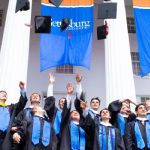
You have trillions of cells in your body—at any given moment some of those cells are dividing and reproducing. There are many reasons why this occurs: cells die and need to be replaced, and cell division is required for growth. Mitosis and meiosis are two types of this division—mitosis occurs to renew and replenish cells across the body, and meiosis is the process by which specialized cells divide. But when something goes wrong—when there’s a mutation in the genes that control the division—it can result in genetic disorders or diseases like cancer.
Biology Prof. Steve James ’80, in collaboration with a colleague from Millsaps College, Sarah Lea Anglin, worked on a project to study cell division, specifically using mutations to discover new genes important to the process. Several Gettysburg students assisted in this research over the course of six years. The end result was a paper published in the prestigious journal Genetics with seven Gettysburg alumni as co-authors— James Barra ’07, Lorela Ciraku ’14, Christina Kelliher ’11, Julie Kobie ’11, Emily Kohlbrenner ’13, Amanda Orzechowski ’13, and Kristin Shingler ’11.
Read below to learn more about their individual contributions to this significant paper and find out where they are today.
Background/Timeline:
- Late 1990s—Using an existing cell division mutant—called nimX (never-in-mitosis)—that can’t divide under certain conditions, Anglin generated a new mutation that was able to overcome the cell division defect of the original nimX mutant.
- This new suppressor mutation became known as snxA (suppressor-of-nimX). According to James, “This traditional approach is a powerful and well-established geneticist’s tool, enabling the discovery of new genes through gene mutation.” However, this approach cannot identify the precise identity and function of the gene that has been mutated.
- 2007—Enter James and his students, who undertook mapping the location of the snxA gene and using genetic engineering and protein biochemistry to identify the physical gene, determine its precise DNA sequence, and learn how the protein encoded by the gene helps to regulate cell division.
James Barra ’07, Biology and Religion (Religious Studies) major, Chemistry minor
Contribution to paper: Discovered that two slightly different protein products are encoded by the single snxA gene.
Where he is now: Orthodontist in Chambersburg, PA
“The most applicable thing I learned from working with Dr. James is professional integrity. As an orthodontist, I am often in a position of diagnosing problems with which patients may not be completely familiar. I owe it to them to be as familiar with the latest dental and orthodontic research as I possibly can and to be forthright and clear in my explanations, just as Dr. James demonstrated in the lab.”
Lorela Ciraku ’14, Biochemistry and Molecular Biology major
Contribution to paper: Following the work of Christine Kelliher ’11, who created a biochemical tag from scratch, Ciraku added that tag to the snxA gene, allowing them to study the protein product of the snxA gene.
Where she is now: Lab tech in the Corwin Lab at the University of Virginia
“The Biochemistry and Molecular Biology program at Gettysburg is excellent for someone who is interested in pursuing a career in research— it’s unique in the great support that faculty members offer students to engage in their research and provide one-on-one trusting mentorship. In my daily work, I encounter certain topics that are not so fresh in my mind, and I like to go back to my notes from Dr. Jennifer Powell’s genetic class or Dr. James’s diagrams on cell cycle regulation. The impact this education and the faculty made on me is tremendous, and it still inspires me to be a better scientist every day.”
Christina Kelliher ’11, Biochemistry and Molecular Biology major
Contribution to paper: Created a biochemical tag that was then added to the snxA gene, allowing them to study its protein product.
Where she is now: Graduate Student in Genetics and Genomics at Duke University
“Science is not an easy career path because experiments fail constantly, and many times the results of a particular hypothesis you were testing don’t fit with any of your original models. Dr. James instills in his students an enthusiasm and work ethic for science that is hard to quantify but essential for success in any career.
Our lab also worked closely with Sarah Lea Anglin’s lab on this paper. I began to learn how to collaborate effectively with colleagues at other universities by watching the communication between Dr. James and Sarah Lea. They often had to coordinate students, generate and send strains, and schedule visits to use different equipment to complete the experiments described in the paper.”
Julie Kobie ’11, Biochemistry and Molecular Biology major, Mathematics minor
Contribution to paper: With Kristin Shingler ’11, used genetic engineering to add Green and Red Fluorescent Protein tags (GFP and RFP) onto the snxA gene, providing an important visual tag for studying the location and behavior of snxA protein within the cell. This research was a part of James’s capstone Molecular Genetics course.
Where she is now: Senior scientist at Merck studying early clinical development statistics. She received her master’s in biostatistics at the University of Pennsylvania and a Ph.D. developing statistical methods in the area of human genetics.
“I recently returned to Gettysburg's campus for the first time since graduation, and it felt like I'd never left. That feeling was truly a testament to Gettysburg College and the absolutely amazing collection of research faculty (and students and alumni), especially in biology and chemistry, who are just as supportive as they were years ago! I am so grateful for the experiences I've had and the relationships I've sustained through Gettysburg College. My lab partner, Kristin Shingler, and I have remained in touch and are still good friends!”
Emily Kohlbrenner ’13, Biochemistry and Molecular Biology major
Contribution to paper: Generated one additional snxA mutant and determined its DNA sequence in order to identify the precise change in DNA sequence that would explain its defective behavior.
Where she is now: Pursuing her Ph.D. in molecular medicine at the University of Washington School of Medicine.
“Learning alongside driven and ambitious peers at Gettysburg set a high standard for entering the workforce. I’ve been conducting molecular neuroscience research in a Harvard Medical School Laboratory for the last 2.5 years, and in that time I’ve been able to present my work at conferences domestically and abroad, become a first author on a manuscript, and complete a master’s degree. The liberal arts education at Gettysburg gave me a love of learning that was just as important to me as the degree on my wall.”
Amanda Orzechowski ’13, Biochemistry and Molecular Biology major
Contribution to paper: Broadened understanding of the role of snxA in cell cycle control by discovering that the ability of snxA mutants to rescue cell cycle defects is limited to defects in cell division and not in DNA copying or other steps in the cell cycle.
Where she is now: Graduate student in the Biomedical Sciences at SUNY Upstate Medical University
“At Gettysburg, I found research colleagues, faculty, and students of good character who understood the importance of integrity, both in research and in life. Gettysburg is quite remarkable in its ability to instill in its students a commitment to serving and supporting the local community and others on a global scale.”
Kristin Shingler ’11, Biology major, Chemistry minor
Contribution to paper: With Julie Kobie ’11, used genetic engineering to add Green and Red Fluorescent Protein tags (GFP and RFP) onto the snxA gene, which led to the discovery that snxA protein localizes mainly to the nucleus of the cell.
Where she is now: Recently received her Ph.D. in Microbiology and Immunology at Penn State University College of Medicine
“Dr. James helped in many ways to guide me on my career path. He taught excellent laboratory skills and aided me in my graduate school search and application process. Since leaving Gettysburg I have completed my Ph.D. at Penn State College of Medicine and have started a postdoctoral research position at the University of Minnesota. The lab skills I gained through work on this project were critical to my acceptance and success in graduate school.”


